Our Mt. Shasta, California Wildlife Pond,
Dragonfly Roost, Part III
2007
The pond slumbers, then reawakens and matures as it lives through its first year:
January found the pond slumbering under a blanket of snow (over the ice).
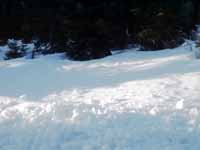
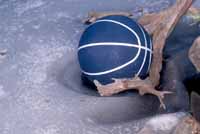
About the "blue ball" - at first it DID keep a hole in the ice next to it, but as the ice thickened,
the hole became smaller and smaller, and as it narrowed it appeared to become a 'trap' for any critter
that tried to use it as a water source. We won't reuse the ball next winter.
February - 2007 was a dry warm winter. The snow was already melting.
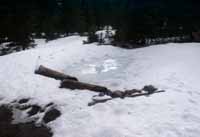 and
and

I decided it was now or wait another year to find out if the pond froze hard enuf to support my weight...
...
so I donned my snow boots and poles and ventured out...
...it didn't even creak!
We didn't make it up to our McCloud home in March, but we did in April:
April - the pond was mostly thawed when we arrived:
It was time to get back to work on the pond. The first thing, we thought, was to get rid of the very dusty dirt
left behind from the home and pond construction. So we brought in pine needles from under nearby pine trees.
The result was wonderful, it looked more natural and every breeze and every step didn't raise dust! :-)
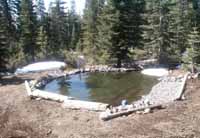
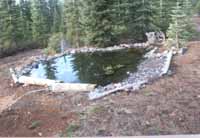


We also brought in some pond plants and placed them temporarily in the shallows to acclimate
and the spillway received more rocks, to make it appear more natural.
The birds and insects returned to the pond and we were AMAZED at how many species came in for drinks &/or baths!
We began trying to document them (in the order seen):
| Birds: | Mammals |
| 1.White-crowned Sparrow | 1.Least Chipmunk |
| 2.Fox Sparrow (MANY!) | 2.Yellow-pine Chipmunk |
| 3.Mountain Chickadee | 3.California Ground Squirrel |
| 4.American Goldfinch | 4.Douglas Squirrel |
| 5.Golden-crowned Sparrow | Insects |
| 6.White-headed Woodpecker | 1.Darner Dragonfly |
| 7.Stellar's Jay | 2. Familiar Bluet Damselfly |
| 8.Audubon's Warbler | 3.Backswimmers (a hundred of so!) |
| 9.Dark-eyed Junco | 4.Diving Beetles |
| 10.Cassin's Finch | 5.Yellow Jackets |
| 11.Spotted Towhee | 6.Water Striders |
| 12.Pine Siskin | 7.Potato Bug/Jerusalem Cricket (2 have drowned!) |
| 13.Red-breasted Nuthatch | 8.Day flying moth |
| 14.Evening Grosbeak | 9. |
Links to pictures we've taken of
these critters and others that have visited our McCloud pond can found at this link:
Shasta Critters
May - the birds AMAZED us; we recorded several new species,
and the dragonflies were wonderful too!
Over Memorial Day, our dragonfly friend, Doug Aguillard, visited.
He took some amazing photos of the birds on our pond one evening, you'll know immediately which images he took:
ALL HIS PHOTOS ARE COPYRIGHTED, you must secure permission to use them!
The deer (they look so scrawny after the winter!) have found the pond, but a 12-spotted Skimmer dragonfly thinks the pond is solely HIS!
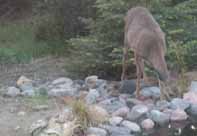

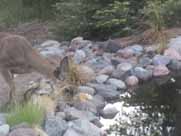
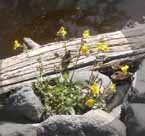
We've begun bringing in some native wetlands plants. The yellow flowers are Seep Monkeyflower.
June - the birds continued to amaze us; several new species visited, and new dragonflies species arrived too!
Our good friends, the Ruges visited and took the first photo below:

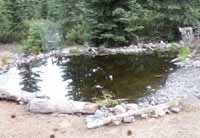
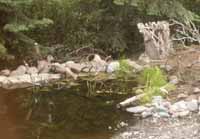
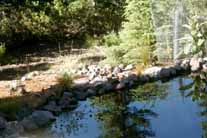
We brought in some new plants from nearby waterways for the bog area, and moved the plants we'd brought in in May to new destinations,
where they looked more natural (nearer to the edges). The yellow flowers are Seep Monkeyflowers.
We also started bringing in more rocks and placing them behind the pond near the overflow, to help make the overflow area look more natural.
I found that if I placed the rocks near some of the grass I'd transplanted, that this helped keep the soil next to them damp.
We bought a native Tiger Lily at nearby Medes Nursery (Mt. Shasta City).
We planted it next to the Quaking Aspen, within the ckicken wire as we're certain our deer would love to eat it.
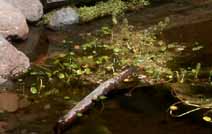
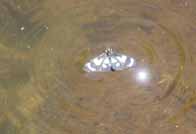
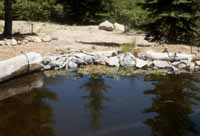
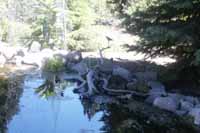
Above are some close-up images of areas of the pond: The first & third images are of the 'corners' of the pond nearest the house.
These are the two areas where we had moved plants to that we'd brought from our Sebastopol, CA pond (originally we just placed them by the steps to 'adjust).
The main plant you see is Pennywort. It's a favorite for the damselflies to perch upon.
Also present are duckweed and fairy moss - tiny floating plants we purposely added to help our immature pond have shade!
But if you look at that image closely, you'll see that a day-flying moth, that tried to land on the Pennywort ended up drowning.
The next image is of the same species of moth. Many moths, and many ringlet butterflies drown in the pond.
But it's all part of the natural cycle of life and death and their bodies help the pond develop a nutrient-rich bottom layer.
We believe they are the "Sierran Pericopid" Gnophaela latipennis. The larval food plant is California Stickweed.
Our low-tech way to keep the pond full is a hose dripping into the pond. We are TOTALLY off the grid here,
and we use 2 solar panels to pump water into a 2500 gallon tank. Then we just run two LONG hoses to the pond.
Someday we'll dig a trench, but for now this works, and our mainly our time is going into finishing the house so we can get our final permit signed.
In the last of the 4 images above you see the 'back' of the pond. Note how tucking just a few plants between rocks helps naturalize the area.
July - the birds and dragonflies and butterflies continue to amaze us, with the #s visisting the
pond increasing:
| Birds: | Dragonflies: |
| 20. Nashville Warbler | 5. Black Saddlebags |
| 21. Lazurli Bunting | 6. Pacific Forktail |
| 22.Mountain Quail with chicks | 7. Shadow Darner |
| 23. American Robin | 8. Common Whitetail |
| 24. Mourning Dove | 9. Variegated Meadowhawk |
| 25. Tree Swallow | 10. Common Green Darner |
| 26. Western Wood Peewee | Mammals: |
| 27. Warbling Vireo | 1. Least Chipmunk |
| 28. Green Tailed Towhee | 6. Black-tailed Deer |
| 29. Brown-headed Cowbird | 7. Weasel |
Note how much healthier the deer are looking!
The pond is showing some algae, but not too much, and it is not at all unusual in a young pond.
Algae is natural, but we net a bit out if it doesn't seem 'pretty' to us.
We know that as the plants mature, algae will be less of a 'problem' (it's not a problem for wildlife, just our aesthetics)

August - our busy lives kept us away until the 3rd week in August.
But we'd let friends camp on our site, and they'd told us about a doe and twin spotted fawns visiting the pond.
We could hardly wait to get to see them!
When we got there their were no longer twins, but we did see a doe with an older fawn who had lost its spots,
another doe with one spotted fawn, a doe with no fawn,
and 2 very young bucks: one with just tiny stubs where his antlers will be someday,
and another buck, perhaps a year older with graceful antlers that curved in a gorgeous pair of 'parenthesis' over his head ( ).
We were only able to get photographs of the does with fawns. The young bucks were very very wary.
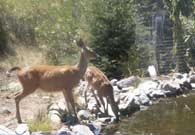
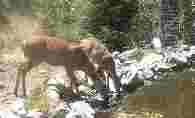
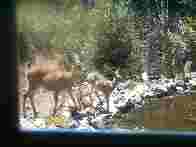
(My apologies - for the 2nd and 3rd of the above images of the deer, I used a program other than Photoshop to resize the images - and permanently ruined them!)
There was a full moon and we discovered that the pond reflected it beautifully. Here our attempts to get it on film:
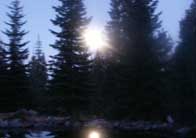
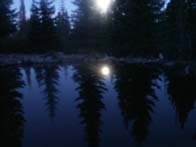
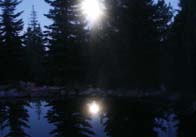
And, we were delighted to find an 'old friend' at the pond: A Cardinal Meadowhawk.
You see, this species of dragonfly is the most common species at our pond in Sebastopol, CA (Bigsnest Wildlife Pond)!
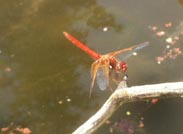

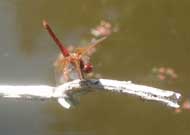
Besides the Cardinal Meadowhawk, we also added another species of dragonfly, and two more species of birds to our pond list.
We were also able to get photos of some of the species that were first seen earlier in the year:
September - We were able to visit and work on the pond in both early and late September.
The number of birds visiting began to drop off, but we did add another new species to bring the total # of species
that have visited to
32: Scrub Jay
Hunting season began and the deer became more scarce, but we did get some images; here's one:
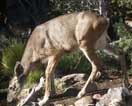
We also got pictures of some other pond visitors: Stellar's Jay, Northern Flicker, White-crowned Sparrow and White-headed Woodpecker



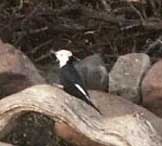
We brought in more plants for the perimeter of the pond. We hope they'll grow and expand! The bog plants have been growing & expanding!

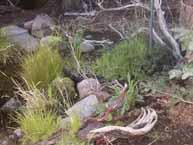
It seems to be an early fall: we even had snowflakes falling by the end of the month.

Here are a few pictures of the pond as it approaches its first birthday:
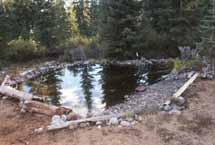
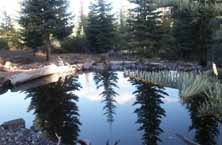
October -
Winter arrived early: I ended up planting my native plants I'd brought in the snow!
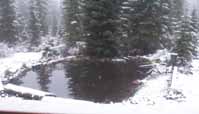
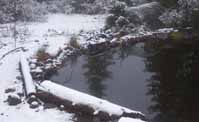

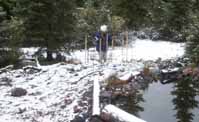
November -
The early snow had melted; but we only got to visit once in November, so there aren't many 'birthday' images
as we'd thought we'd be back sooner.
As it was, we weren't able to return until January.
2006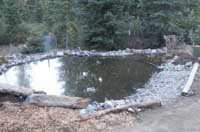 The pond a year ago
.......2007
The pond a year ago
.......2007 The pond at 1 year
The pond at 1 year
We felt the pond had not changed all that much. I guess change is slower at this elevation as our
Sebastopol pond changed so much more its first year...
...and then again, we were only on our Shasta property a few times.....
But, we did add one new species to the pond's list of wildlife visitors:
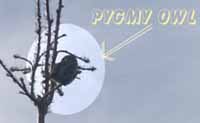 Bird 32. Northern Pigmy Owl
Bird 32. Northern Pigmy Owl
We think he'd learned to come to the pond where he'd prey on the many small birds and chipmunks that visited!
Sorry the photo isn't better.
He had the nerve to SCOLD me when I walked by....!!
Due to circumstances, we weren't able to return in late November or December.
When we next saw the pond, it was January 1, 2008 - and we were in for a RUDE surprise.
Click here to see the pond that day
Back to Dragonfly Roost's First page
or
Back to Kathy & Dave's FIRST pond, Bigsnest Wildlife Pond











































 The pond a year ago
The pond a year ago The pond at 1 year
The pond at 1 year Bird 32. Northern Pigmy Owl
Bird 32. Northern Pigmy Owl